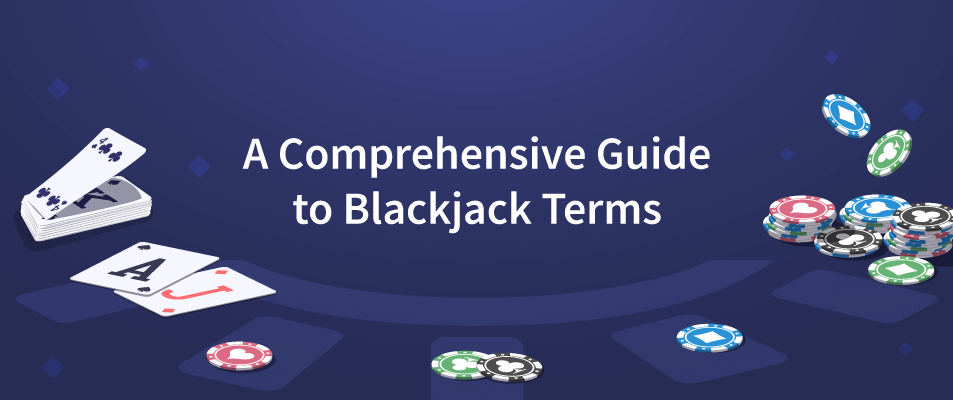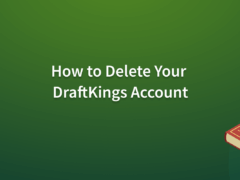Join our subscription list to get access to new bonus offers, online casino reviews, and industry news all in one newsletter!
Blackjack Terminology: A Comprehensive Guide to Blackjack Terms

 3.2K
3.2K
It’s difficult to picture a modern casino without a blackjack table. A true casino classic, the game has been popular for centuries across the globe. And today, blackjack is the most popular casino card game of all.
Whether playing live or online, blackjack appeals for a variety of reasons. It’s easy to understand and offers plenty of action, but above all, it is beatable. That’s right – by combining basic strategy with advanced card counting techniques, it’s possible to win in the long-term.
Suppose you’re a fan of blackjack and live in WV. In that case, you’re in luck – with the state’s new laws legalizing online gambling, there are now many reputable sites that offer a wide variety of blackjack games; check out this helpful West Virginia online casinos list to get started on your virtual gaming adventure.
However, before you can reach that advanced stage, it’s crucial to know the most common blackjack terms and rules. In this article, we’ll take the first step by teaching you the most important blackjack lingo to help you get by.
Blackjack Terms Explained
Newcomers to this popular casino game usually have a lot of questions. How does Insurance work? What is DAS in blackjack shorthand? When do I have a soft hand? And who on Earth is Five Card Charlie?
Let’s find out the answer to all of these quandaries, and many more besides, with our comprehensive glossary of blackjack terms.
A
Ante. Everyone seated at the table that wishes to participate in a Hand must place a bet. This wager is often known as an Ante.
B
Basic Strategy. Somewhat paradoxically, Basic Strategy is actually a fairly advanced way to play blackjack. We know from computer simulations exactly what the best possible move is in any given situation. And since blackjack has been “solved”, we can build our strategy around that knowledge. This is dubbed Basic Strategy.
Bet Behind. Most blackjack games allow you to Bet Behind. Whether seated at the table or simply watching, you can place chips behind any player’s Ante. The result of your wager is determined entirely by the outcome of that player’s Hand. If they win, you win, including enhanced payouts for a Natural Blackjack.
Blackjack. Also called a natural blackjack, this is when you make 21 with your starting hand, combining an Ace plus a 10-value card. There is usually an increased reward of 3 to 2 if you manage this, though each game has different rules. If you split a pair and then make 21, this is almost never classed as a natural.
Box. Every player has a small painted area in front of them on the table. There are spaces in which to place the cards, as well as your Ante. This bet goes into the single rectangular space, known as the Box.
Burn. After the Dealer performs a Shuffle, the very first card to be dealt from the Shoe is discarded. This procedure is for security reasons, in case someone accidentally saw it and might gain an Edge. Any discards are also known as Burn cards.
Bust. The object of blackjack is to beat the Dealer’s score without getting more than 21. If you end up with 22 or higher, you’re out of the game and are said to be Bust. The Dealer can also go Bust, which is good news for everyone remaining in the Hand.
C
Counting (or Card Counting). Any system that is employed with the specific purpose of tracking cards dealt at a blackjack table. The intention is to wait until there are more cards that are good for the player than bad, then increase bet sizes. Popular Counting systems include Hi-Lo, Zen Count and KnockOut.
Cut Card. A single piece of plastic the exact same size and shape as a regular playing card. It is randomly inserted into the Deck by the Dealer, cutting it in two. When the dealer reaches the Cut Card, it’s time to Shuffle the shoe.
D
DA2. Most casinos employ this rule, which allows you to Double Down with any two cards in your hand. It stands for “Double Any 2”. See also DOA.
DAS. Double After split, a specific rule allowing a player to double down after they split a hand, which can be beneficial.
Dealer. A person responsible for distributing the cards is known as the Dealer. However, the term more commonly refers to the hand they are playing, rather than the person. After all, every player at the blackjack table is aiming to beat the Dealer.
Deck. The proper name for a set of 52 traditional playing cards. Most forms of blackjack employ multiple Decks, though it’s possible to find Single Deck games which have a much lower House Edge.
DOA. This means “Double On Any”, meaning a blackjack game where it’s possible to Double Down with any two cards. See also DA2.
Double Down. Depending upon the exact rules, players usually have the option to place an extra Ante on the table after seeing their cards. This allows them to increase the potential returns from a strong Hand, but in exchange, they may only take one further card. If your total is 9, 10 or 11, you’re likely to want to Double Down.
Double Exposure. A specific form of blackjack where both of the Dealer’s cards are exposed, instead of having one Upcard with a hidden Hole Card.
E
Edge. If a player has an advantage over the casino, most likely through Counting, they are said to have an Edge. The term is more commonly associated with House Edge, however.
Even Money. In some forms of the game, if the Dealer has Blackjack, you lose even if you also have a Natural Blackjack. If that’s the case, you may be offered an Even Money payout when the Dealer shows an Ace.
F
Face Cards. One of several blackjack terms meaning a card from Jack through to Ace. Others include Monkey, Paint, Picture Cards and Royals.
First Base. The seat on the immediate right of the blackjack table from a player’s perspective, or the far left as the Dealer looks. The first position to act in a Hand.
Five Card Charlie. This rule states that a player automatically wins if they have five cards in their hand but don’t Bust. It is not found in all blackjack games.
Flat. Wagering consistent Ante amounts every single hand is called Flat betting.
H
Hand. This has two meanings. First, it refers to your own specific cards. The initial two are your starting Hand, but you can continue to Hit and add more cards. However, the term can also refer to an entire game round.
Hard. If your total is inflexible because it doesn’t contain an Ace, it is referred to as Hard. For instance, 8-6 is worth 14, but so is A-3. The latter is worth both 4 and 14 and so is said to be Soft, while the former is titled Hard 14.
Hit. If you wish to take an additional card, you will tell the Dealer that you will Hit. Whatever you do, don’t say “twist”!
Hole Card. Any card turned face-down is said to be “in the hole”, hence the term Hole Card. In blackjack, only the dealer will have a Hole Card.
House Edge. All casino games have an in-built mathematical advantage slanted in favour of the house. That’s how they make a profit in the long run. Whenever an Edge favours the casino, or “house”, it is called a House Edge.
I
Insurance. A type of Side Bet offered in some, but not all, blackjack variants, if the Dealer shows an Ace. Usually paying 2 to 1, it offers protection in the event that the Dealer really does have 21.
N
Natural (or Natural Blackjack). See Blackjack.
NDAS. “No Double After Split”. As opposed to DAS.
No Win. See Push.
NRSA. “No Re-splitting Aces”. As opposed to RSA.
P
Pair. Two cards of matching value, but not necessarily suit. For instead, 8-8, J-J or A-A. In blackjack, you are usually allowed to Split a Pair.
Pat Hand. In card games, the term “pat” means a ready-made hand that requires no assistance to improve. In blackjack, according to Basic Strategy, you should never Hit when your total ranges from 17 to 21. Any such holding would be an example of a Pat Hand.
Peeking. Some variants insist upon the Dealer checking their Hole Card to see if they have a Blackjack when an Ace is showing. This is called Peeking. European Blackjack is one game that does not use this rule, but most do.
Penetration (or Deck Penetration). This refers to the number of cards which have been dealt in a particular Shoe. The more Hands played, the deeper we’ve penetrated into the Shoe or Deck(s). This blackjack term is most commonly used by those who are Counting.
Perfect Strategy. See Basic Strategy.
Push. If the total value of your cards is exactly equal to those of the Dealer, there is a tie. In this case your bet is returned, which is known as a Push. The Dealer may also declare “No Win” rather than “Push”.
R
RSA. Shorthand for “Re-Splitting Aces”. This is not a common rule, but some blackjack games do allow the re-splitting of Aces. In other words, if you Split a Pair of Aces and make another, you may Split again. As opposed to NRSA.
Running Count. When Counting, players must keep a Running Count in order to approximate how many advantageous cards are in the deck. This is later converted to a more realistic value known as the True Count.
S
Shoe. The special container used by the Dealer to house the cards after the Shuffle is performed.
Shuffle. Once the Cut Card appears, the Dealer cannot deal any more game rounds from that Shoe. Instead, all cards are randomly mixed together in what is referred to as a Shuffle, before being placed back into the Shoe.
Side Bet. Almost all blackjack games offer Side Bets, which are additional wagering opportunities designed to generate more action. Examples include 21+3, Perfect Pairs and Royal Match. Insurance and Bet Behind could also be classed as Side Bets.
Single Deck. A specific blackjack game which uses a solitary 52-card Deck, instead of multiple Decks in the Shoe. Since it’s easier for the player to Count, the House Edge is lower and there may be different payouts as a result.
Soft. A hand containing an Ace is said to be Soft, since it effectively has two separate values. For instance, A-5 is worth both 6 and 16 at the same time. If you were to take a card and Bust, the lower value comes into play. As opposed to a Hard total.
Split (or Splitting). Whenever you’re dealt a Pair, you may choose to Split. Here, one of each card is used to form two separate hands, with addition of two extra cards from the Shoe. Naturally, an additional Ante is placed, as you’re now playing two distinct hands. If another Pair is dealt as a consequence of the Split, you may be allowed to Split again, depending on the rules.
Stand (or Stay). If you’re happy with your hand, you can instruct the dealer that you do not wish to take any further cards. This is indicated with the command Stand, or Stay. Standing would be especially appropriate if you hold a Pat Hand, but you may Stand whenever you like.
Stiff. Any total where you should draw another card, but that could potentially leave you Bust, is said to be Stiff. In other words, values of 12 through 16.
Surrender. The Surrender rule does not apply in some forms of blackjack, particularly when playing online. Where implemented, it allows players to give up and take back half of their bet. Early Surrender permits you to give up before the Dealer checks for Blackjack. Late Surrender, on the other hand, is only allowed after Peeking.
T
True Count. Players who are Counting will take the Running Count and convert it to an actual value using a mathematical formula. The calculation varies according to the Counting method being used, but it results in what is called the True Count.
Twenty-One (or 21). Another term for Blackjack. It can refer to making a Natural Blackjack, acquiring 21 with three or more cards or the name of the game itself.
U
Upcard. The opposite of a Hole Card, an Upcard is a visible card on the blackjack table. It usually refers to the one belonging to the Dealer, but players are also dealt Upcards.
It’s Time to Test Your Blackjack Lingo
Now that you’re clued up on the most important blackjack terminology, you should feel much more confident when hitting the tables. Whether you intend to play at a local venue or one of the best sites in WV for online casino blackjack, you’re all set. To learn more about blackjack, you might want to read one of the best books about gambling and blackjack, The World’s Greatest Blackjack Book by Lance Humble.
However, it’s important to remember that playing blackjack, like any form of gambling, carries a level of risk. Even if you are capable of playing flawless strategy and counting cards, you will still experience losing sessions. It’s vital to remain in control of your emotions at all times.
Please play responsibility, never risking more than you can afford to lose. A solid understanding of roulette terminology can be beneficial for players looking to enhance their gameplay and increase their chances of winning big; fortunately, resources like this comprehensive roulette glossary make it easy to learn the ins and outs of key terms like “black bet,” “even money,” and “high bet.” Don’t chase losses, avoid playing when stressed or intoxicated and take regular breaks to avoid fatigue. Good luck and enjoy the game!










